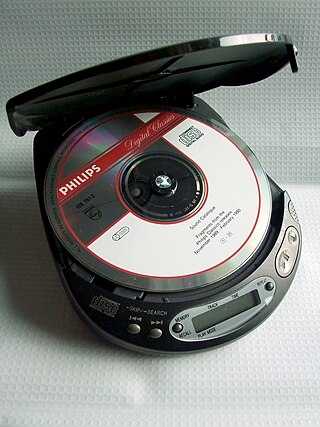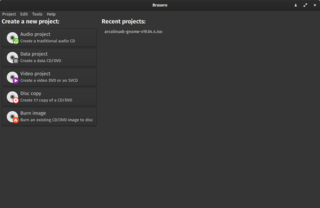Features
WaveBurner has several notable features:
| Developer(s) | Apple Inc. |
|---|---|
| Stable release | 1.6.1 / November 4, 2009 |
| Operating system | Mac OS X v10.6/Mac OS X v10.4 |
| Type | Multimedia Content Creator |
| License | Proprietary |
| Website | Apple’s Logic Utilities page |
WaveBurner was a Mac OS X professional application (proapp) bundled with Logic Studio for assembling, mastering, and burning audio CDs. Audio CDs created with WaveBurner could be played back on any audio CD player, and could be used as premasters to produce CDs in large numbers for possible distribution.
WaveBurner has several notable features:

The compact disc (CD) is a digital optical disc data storage format that was co-developed by Philips and Sony to store and play digital audio recordings. In August 1982, the first compact disc was manufactured. It was then released in October 1982 in Japan and branded as Digital Audio Compact Disc. It was released on March 2, 1983 in North America and Europe.

CD-R is a digital optical disc storage format. A CD-R disc is a compact disc that can be written once and read arbitrarily many times.
Waveform Audio File Format is an audio file format standard, developed by IBM and Microsoft, for storing an audio bitstream on personal computers. It is the main format used on Microsoft Windows systems for uncompressed audio. The usual bitstream encoding is the linear pulse-code modulation (LPCM) format.

Compact Disc Digital Audio, also known as Digital Audio Compact Disc or simply as Audio CD, is the standard format for audio compact discs. The standard is defined in the Red Book, one of a series of Rainbow Books that contain the technical specifications for all CD formats.

Video CD is a home video format and the first format for distributing films on standard 120 mm (4.7 in) optical discs. The format was widely adopted in Southeast Asia, South Asia, China, Hong Kong, Central Asia and the Middle East, superseding the VHS and Betamax systems in the regions until DVD-Video finally became affordable in the first decade of the 21st century.

A CD player is an electronic device that plays audio compact discs, which are a digital optical disc data storage format. CD players were first sold to consumers in 1982. CDs typically contain recordings of audio material such as music or audiobooks. CD players may be part of home stereo systems, car audio systems, personal computers, or portable CD players such as CD boomboxes. Most CD players produce an output signal via a headphone jack or RCA jacks. To use a CD player in a home stereo system, the user connects an RCA cable from the RCA jacks to a hi-fi and loudspeakers for listening to music. To listen to music using a CD player with a headphone output jack, the user plugs headphones or earphones into the headphone jack.

In computing, an optical disc drive is a disc drive that uses laser light or electromagnetic waves within or near the visible light spectrum as part of the process of reading or writing data to or from optical discs. Some drives can only read from certain discs, but recent drives can both read and record, also called burners or writers. Compact discs, DVDs, and Blu-ray discs are common types of optical media which can be read and recorded by such drives.
An optical disc image is a disk image that contains everything that would be written to an optical disc, disk sector by disc sector, including the optical disc file system. ISO images are expected to contain the binary image of an optical media file system, including the data in its files in binary format, copied exactly as they were stored on the disc. The data inside the ISO image will be structured according to the file system that was used on the optical disc from which it was created.
Optical disc authoring, including CD, DVD, and Blu-ray Disc authoring, is the process of assembling source material—video, audio or other data—into the proper logical volume format to then be recorded ("burned") onto an optical disc. This act is usually done illegally, by pirating copyrighted material without permission from the original artists.

K3b is a CD, DVD and Blu-ray authoring application by KDE for Unix-like computer operating systems. It provides a graphical user interface to perform most CD/DVD burning tasks like creating an Audio CD from a set of audio files or copying a CD/DVD, as well as more advanced tasks such as burning eMoviX CD/DVDs. It can also perform direct disc-to-disc copies. The program has many default settings which can be customized by more experienced users. The actual disc recording in K3b is done by the command line utilities cdrecord or cdrkit, cdrdao, and growisofs. As of version 1.0, K3b features a built-in DVD ripper.
The double-density compact disc (DDCD) is an optical disc technology developed by Sony and Philips using the same 780 nm laser wavelength as a compact disc. The format was announced in July 2000 and is defined by the Purple Book standard document. Unlike the compact-disc technology it is based on, DDCD was designed exclusively for data, with no audio capabilities.
CD/DVD copy protection is a blanket term for various methods of copy protection for CDs and DVDs. Such methods include DRM, CD-checks, Dummy Files, illegal tables of contents, over-sizing or over-burning the CD, physical errors and bad sectors. Many protection schemes rely on breaking compliance with CD and DVD standards, leading to playback problems on some devices.
A cue sheet, or cue file, is a metadata file which describes how the tracks of a CD or DVD are laid out. Cue sheets are stored as plain text files and commonly have a .cue filename extension. CDRWIN first introduced cue sheets, which are now supported by many optical disc authoring applications and media players.
Cross-platform Audio Creation Tool (XACT) is an audio programming library and engine released by Microsoft as part of the DirectX SDK. It is a high-level audio library for authoring/playing audio that is written to use Xaudio on the Xbox, DirectSound on Windows XP, and the new audio stack on Windows Vista and Windows 7. Xaudio is an Xbox-only API designed for optimal digital signal processing. XACT also includes X3DAudio, a spatialization helper library available on both platforms, Windows and the Xbox. XACT was originally developed for Xbox development, and was later modified to work for Microsoft Windows development as well.
A mixed mode CD is a Compact Disc which contains both data and audio in one session. Typically the first track is a data track while the rest are audio tracks. The most common use for mixed mode CDs is to add CD-quality audio to video games on a CD.

CD-RW is a digital optical disc storage format introduced in 1997. A CD-RW compact disc (CD-RWs) can be written, read, erased, and re-written.

Brasero is a free and open-source disc-burning program for Unix-like operating systems, it serves as a graphical front-end to cdrtools, cdrskin, growisofs, and (optionally) libburn. Licensed under the terms of the GNU General Public License.

Logic Studio is a discontinued professional music production suite by Apple Inc. The first version of Logic Studio was unveiled on September 12, 2007. It claims to be the largest collection of modeled instruments, sampler instruments, effect plug-ins, and audio loops ever put in a single application.

A CD-ROM is a type of read-only memory consisting of a pre-pressed optical compact disc that contains data. Computers can read—but not write or erase—CD-ROMs. Some CDs, called enhanced CDs, hold both computer data and audio with the latter capable of being played on a CD player, while data is only usable on a computer.